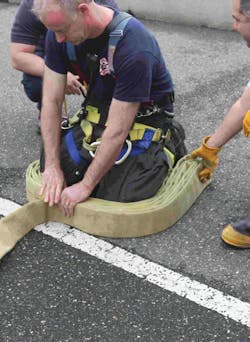In our first article in this series, we broke the ice as to the need for a standpipe hose system that consists of multiple items. The “system” that we identified consists of three elements that are each carried by a firefighter to the floor below the fire in the typical high-rise setting.
Let’s take a look at this system as it applies to a fire department that may be faced with staffing constraints, yet is obligated to provide an effective initial-attack capability. Standpipe equipped buildings come in various types. For example, we can have standpipe operations in residential or commercial high-rise buildings that are of fire-resistive construction, we could be faced with large square-footage commercial occupancies that are only a few levels, but are massive in scope, or we could be faced with occupancies that have standpipe systems, but may present construction and height features far different from the traditional high-rise building. Nevertheless, our fire departments have to be able to overcome any eventuality and get a sufficient amount of water on the fire in a safe manner. The high-rise hose pack “system” is such a tool in the toolbox!
In this article, we’ll discuss how to put the system together, the various accessories that should be included and where they should be carried. It’s important to remember that weight issues can rapidly debilitate our members, so it’s a must that we evenly distribute the necessary items.
Furthermore, all of the needed items to initiate a fire attack have to be carried in a fashion so that the weight being carried causes the least amount of stress and provides a means where the firefighter has the freedom to maneuver.
Packing the System
The system consists of three separate elements:
- 100 feet of 2 1/2-inch hose (2 x 50-foot lengths connected together) with a 1 1/4-inch smoothbore nozzle. The nozzle is a break-apart type nozzle where the tapered bore can be removed leaving you with a shut off and 1 1/2-inch male threads
- 100 feet of 2 1/2-inch hose (like above) but instead of a nozzle, this pack has an inline pressure gauge on the female coupling
- A heavy-duty bag with a closure-type opening on top. This allows for various appliances to be carried without the fear of them falling out if the bag is dropped
To create this system, you will also need 3 x 48-inch long seatbelt-type straps and 1 by 48-inch piece of 1-inch webbing tied in a loop for each hose pack. The seatbelt straps keep the hose tightly together and the webbing allows for control of the pack as members are ascending the stairs. Therefore you need six straps and two pieces of webbing. The tool bag for the various tools and appliances has to be heavy duty and must have long shoulder straps so a member can carry this bag over his shoulder allowing him the freedom of both hands.
The tool bag has a few items of significance that compliment the standpipe hose pack system. Take a look at part one of this series for a detailed explanation of what’s carried in the bag and why.
To begin creating this system, start by having enough room to work, such as the apparatus bay. The steps for creating the first hose pack described above are fairly simple.
- One firefighter, in bunker pants because of the kneepads provided, kneels down and places the female coupling against his left ankle (see Photo 1).
- The hose is then wrapped around his knees to the right ankle and back again to where we started.
- This continues until we get to the second coupling (see Photo 2).
- When the next length of hose is attached, we start a second row immediately above and continue until we get to the male coupling.
- The nozzle is then placed on the line.
- At three separate points on the pack, about a foot from each end and at the center, the seatbelt straps are secured tightly (Photo 3).
- Near the upper most portion of the pack, a piece of tubular webbing is interlaced through a single fold of hose, thus creating a loop (see Photo 4). This strap is not designed to carry any weight, but simply to pull the hose pack taught in the event the firefighter feels it is starting to slip off (see Photo 5).
The second pack is very similar to the first.
- Connect the inline pressure gauge to the female coupling.
- Begin packing this hose pack, as above, except place the inline gauge at your left ankle and continue to pack the hose as above.
- The male couple is at the end and has nothing attached to it.
- Place the three seatbelts in position, as we did above, and the same with the webbing strap.
- Notice in Photo 6 how the firefighter carries this pack without any problems.
The tool bag is prepared by placing the length of rolled hose in first and all the needed items are placed next to it. The bag should be big enough to carry these items, but not so big that it’s awkward.
The three-item system can fit in an area approximately 34 inches wide by 18 inches deep by 18 inches high. See the photo for how this three-part system easily fits into a cabinet on an apparatus (see Photo 7). Different sized cabinets may require some adjustment, but luckily the two hose packs and tool bag don’t take up that much space.
Transporting the System
The convenience of deploying the system is that the weight load is equally distributed among the members of a three-person engine company. The way the items are carried permits greater control and safety because of the “hands-free” carrying methods. Each of the two hose packs in the system is carried over the top of the self-contained breathing apparatus (SCBA) cylinder. When each hose pack is placed on top, so that the weight is as close to the firefighters back as possible, the hose will not fall off. With the SCBA waist strap secured properly, all of the weight is carried on the hips making for a very comfortable means of carrying such an awkward load.
The tool bag also carries a variety of accessories and is equipped with a lengthy shoulder strap that allows for a member to pick up the bag, place his arm through it and ascend up the interior stairs with the freedom of both hands. The freedom of both hands permits additional items to be carried or allows for members to hold on to the handrails.
One Note To Standpipe Flows
While the high rise hose pack system that we have discussed so far gives us a lot of flexibility and options, you must be familiar with the flow characteristics of the standpipe systems in your community. For example, the Class 1 and Class 3 standpipe systems are designed to provide adequate flows to supply our hose pack system, but the Class 2 system could prove to be woefully inadequate. We have a lot of flexibility with the items we bring with us to hook up a 2 1/2-inch line to the 1 1/2-inch threads of a Class 2 standpipe outlet, but remember that the Class 2 system was never designed for large handline flows. Sure, we have the ability to hook up to the outlet with the items we have discussed, but if the fire protection system is only flowing a limited amount of water, you better think of alternate strategies way ahead of time. As a good rule of thumb, stretch from the apparatus if the building is equipped with only a Class 2 standpipe system. The bottom line is know your buildings fire protection features ahead of time and what flows are realistic. This will help you to formulate a safe and effective strategy.
Summary
The ability to pack the system, carry it in a fashion that limits stress and distribute the weight among a team of firefighters are all key elements in the system. In addition, having the proper tools and appliances ready for most eventualities is also a key factor. One additional note, whenever members ascend to the upper reaches of the fire building, it’s important that they don’t drop or throw the high-rise pack components on the ground. A damaged coupling or nozzle means that someone has to go downstairs and get a replacement item. Remember what we said about reflex time in the previous article; from the time the alarm is received to the time water is flowing can be a while. Don’t make things worse by accidentally damaging a key component.
In the meantime, until our next article in this series, try the following these drill ideas.
- Assemble the makings for such a hose-pack system. If you don’t have seatbelts or webbing, use short lengths of rope to tie off the components.
- Try placing a single 100-foot hose pack on top of the SCBA cylinder on a firefighter’s back. Make sure to drape the webbing over their chest for better control as shown in the photo 5.
- Assemble the makings for the tool bag. Do you have extra accessories lying around that you can spare? Or must you acquire them before putting this system into service? Do you have a suitable heavy-duty tool bag?
- Do you have a 2 1/2-inch hose? This is a scary question because many departments seem only to have 5-inch for supply and 1 3/4-inch for attack. This can lead to real problems!
ARMAND F. GUZZI JR. has been a member of the fire service since 1987. He is a career fire lieutenant with the City of Long Branch, NJ, Fire Department and is the deputy director of the Monmouth County, NJ, Fire Academy where he has taught for over 20 years. He has a masters degree in management and undergraduate degrees in fire science, education, and business administration. View all of Armand's articles here. He can be reached via e-mail at [email protected] or [email protected].
About the Author

Armand Guzzi
Firehouse.com Contributor
Armand F. Guzzi, Jr. has been a member of the fire service since 1987. He recently retired a career fire lieutenant with the City of Long Branch, NJ, Fire Department and is the deputy director of the Monmouth County, NJ, Fire Academy where he has taught for over 20 years. He has a Master's degree in management and undergraduate degrees in fire science, education, and business administration. View all of Armand's articles here. He can be reached via e-mail at [email protected] or [email protected].
